Keywords
|
| Maximum ratio combining(MRC), Automatic Gain Control (AGC), multicarrier code-division multiple access (MC-CDMA), Bit error rate(BER),spreading sequences (SS). |
INTRODUCTION
|
| Wireless communication is theconvey of information over a distance without the utilize of electrical conductors or "wires". The continued increase of data, video and voice communication over the Internet, so that the mobile telephony large potential for mobile multimedia system [1]. Due to normal growth of multimedia communication, the sender require elevated data rate communication systems in wireless communication To provide the requirements new technologies 4G is residential in which the Code Division Multiple Access and Orthogonal Frequency Division Multiplexing (OFDM) are new communication systems. MC-CDMA becustomized method for elevated speed data rate communication system [2] |
| In CDMA systems all users transmit in the same bandwidth simultaneously. Communication systems following this concept are "spread spectrum systems''. In this transmission technique, the frequency spectrum of a data-signal is spread using a code uncorrelated with that signal. As a result the bandwidth occupancy is much higher then required. The codes used for spreading have low cross-correlation values and are unique to every user. This is the reason that a receiver which has knowledge about the code of the intended transmitter is capable of selecting the desired signal. |
MC-CDMA
|
| MC-CDMA is a new inflection method which uses multi-user broadcast of Direct Sequence CDMA signals [8]. MC-CDMA is grouping of Orthogonal Frequency Division Multiplexing (OFDM), a multicarrier modulation, and Code Division Multiple Access (CDMA), a increase spectrum technique .Orthogonal Frequency Division Multiplexing (OFDM) is a multi carrier modulation, where a single data stream is transmit over a number of subcarriers. So that using a great number of sub-carriers, a high sound immunity against multipath can be provide so that the symbol duration Ts on each stream will be added large than the channel time dispersion This result the effects of ISI will exist minimized [3]. |
MCCDMA Transmitter
|
| We consider the downlink of an MC-CDMA network in which the total number of subcarriers, N, is divided into smaller groups of Q elements By exploiting the subcarriers of a given group, the BS simultaneously communicate with K active users(K # Q), which are separated by their specific spreading codes (typically chosen froman orthogonal set). Without loss of generality, we concentrate on a single group.Figure illustrates the transmit side of an MC-CDMA system. The symbol ak of the kth user is spread over Q chips using a unit-energy spreading sequence ck = [ck(1), ck(2),. . , ck(Q)]T . Depending on the specific application, a large amount of differentspreading codes can be used. However, a detailed analysis of the spreading module multiplies each data symbol of a user by the user-specific spreading code. Spreading codes are chosen here more with respect to their impact on the PAPR and signal dynamic range than to their orthogonality properties. The commonly used codes in the asynchronous uplink are Gold codes.Each data symbol of a user is then multiplied by the square root of the power allocated by the BS to the user. |
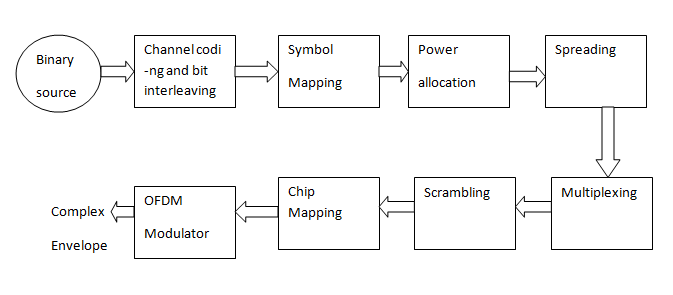 |
MC-CDMA Receiver
|
| At the receiver, the received signal is first sampled and OFDM demodulated by removing the guard interval and performing the DFT operation. The resulting chips are then demapped according to the chip mapping strategy employed by the transmitter. After descrambling with a locally generated synchronous replica of the BS-specific scrambling code, detection including despreading and equalization is performed in order to obtain the decision variable stream of the desired user. ïÿýïÿýThe decision variables are then symbol demapped providing either hard or soft values of the received bits, which in turn are then de-interleaved and decoded in order to recover the transmitted binary information. |
| Which is then frequency interleaved with the contributions of the other groups. The resulting N-dimensional vector z is finally mapped on N subcarriers using an OFDM modulator, comprising an IDFT unit and the insertion of a CP. which is then frequency interleaved with the contribution of the other groups. The resulting N-dimention vector Z is finally mapped on N subcarrier using an OFDM modulator .comprising an IDFT unit and the insertion of a CP |
 |
| MC-CDMA techniques are suitable for transmissioion on multipth channel in fact it`s possible to take advantage of the natural diversity provided by techniques and its possible to recover the orthogonality of the signal by low-complexity reception algorithums |
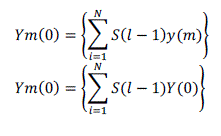 |
AWGN Channel
|
| The simplest channel environment is Additive-White-Gaussian-Noise (AWGN) channel. The white noise can come from the thermal noise for each receive antenna. The signal from the MTh transmit antenna to the nth receive antenna experiences propagation loss in the wireless channel. Additive white Gaussian noise (AWGN) is the commonly used to transmit signal while signals travel from the channel and simulate background noise of channel. The arithmetical appearance inside received signal is r(t) = s(t) + n(t) where s(t) is transmitted signal and n(t) is background noise. |
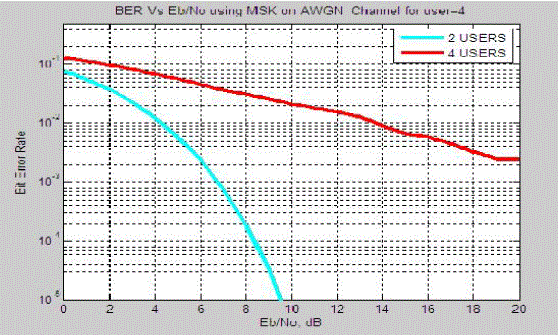
Fig-2MC-CDMA on AWGN for 2,4 users |
| Rayleigh Channel |
| The delays associated with different signal paths in a multipath fading channel change in an unpredictable manner and can only be characterized statistically. While present are large sums of paths, the central bound theorem can be useful to mould the time-variant impulse response of the channel as a complex-valued Gaussian chance process. When the impulse reaction is model as a zero mean complex-valued Gaussian course the channel be supposed toward be a Rayleigh loss channel. The Rayleigh fading is primarily caused via multipath response Rayleigh fading is a numerical model intended for the effect of a propagation environment on a radio signal. The Rayleigh distribution isfrequently used to model multipath fading with no direct line-of-sight (LOS) path [7]. |
BER Performance of MC-CDMA System on Rayleigh and AWGN Channel
|
| when Rayleigh fading is added to AWGN the channel and simulation result show the behaviour of fading on the BER of MC-CDMA system.MC-CDMA Performance effected on AWGN and Rayleigh channel which have two user, four users every user sends ten thousand bits on both the channel. The data were spread using 4-bit Walsh code and modulated using Minimum Shift Keying modulation. For user 2 the simulation result shows that bit error rate is higher compare to user 4 and starts to decrease from SNR= -1dB to 6dB.is also decrease for 2,4,16,32,64 users on AWGN and Rayleigh fading channel.so that MSK modulation is quite efficient for BER of MC-CDMA rather than BPSK on both AWGN and Rayleigh channel. |
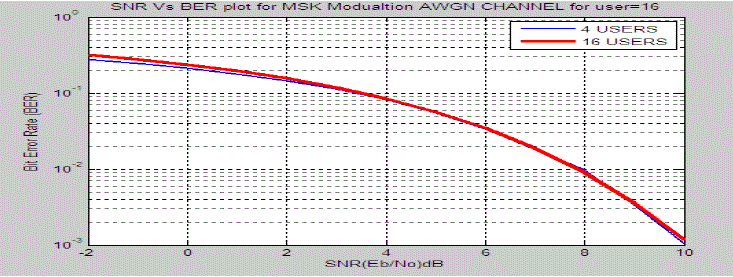
Fig-3 MC-CDMA on AWGN and Rayleigh for 4,16 User |
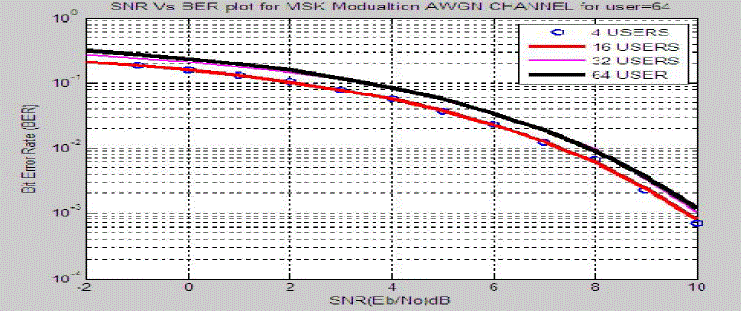
Fig-4 MC-CDMA on AWGN and Rayleigh for BPSK |
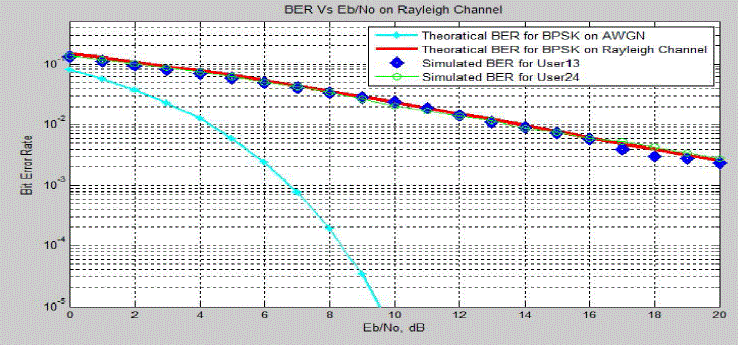
Fig -5 MC-CDMA on AWGN and Rayleigh using BPSK |
CONCLUSION
|
| This paper has presented and showed that BER Performance of MC-CDMA using Walsh code with MSK modulation on AWGN and Rayleigh Fading channel The BER of MC-CDMA with MSK modulation on AWGN channel show that BER is directly vary with number of users .But BER is decrease with MSK modulation as compare BPSK modulation. When compare the BER of MC-CDMA using MSK modulation with BPSK modulation, the result sis also decrease for 2, 4,16,32,64 users on AWGN and Rayleigh fading channel.so that MSK modulation is quite efficient for BER of MCCDMA rather than BPSK on both AWGN and Rayleigh channel.how that BER is more decrease for 2, 4,16,32,64 users on the AWGN channel.BER of MC-CDMA with MSK. |
References
|
- S.Sivanesskumar, R.Sukanesh, “Performance Analysis of Multi-Carrier Code Division Multiple Access System under Clipping Noise,”2008
- A. Sharmila and Srigitha S. Nath“Performance of MIMO Multi-Carrier CDMA with BPSK Modulation in RayleighChannel” InternationalConference on Computing and Control Engineering (ICCCE 2012), 12 & 13 April, 2012.
- Poonam Singh R. V. Raja Kumar T. S. Lamba“Performance analysis of MC-CDMA System in Multipath fading channel”IEEE, May 2006.
- Dinan, E.H.; Jabbari, B., "Spreading Codes forDirect Sequence CDMA and Wideband CDMA Cellular Networks," IEEE CommunicationsMagazine, Vol. 36 Issue 9, pp.5-54, September 1998.
- Mosa Ali Abu-Rgheff, "Introduction to CDMA Wireless Communications," Elsevier Ltd., 2007, pp. 222-223.
- Marvin K. Simon, Mohamed-Slim Alouini, "Digital Communication over Fading Channels ," John Wiley & Sons, Inc., 2000, pp.18-20
- V.Jagannaveen,K.MuraliKrishna , K.RajaRajeswari “performance analysis of MC-CDMA and OFDM in wireless Rayleigh channel”InternationalJournal of Advanced Science and Technology Vol. 25, December, 2010.
- P. M. Dayal, U. B. Desai and A. Mahanta, Minimum conditional probability of error detection for MC-CDMA, IEEE International Symposiumon Spread Spectrum Techniques and Applications, Aug. 30-Sept. 2 2004.
- Rappaport, T., Wireless Communication: Principles and Practice. New Jersey: Prentice Hall, 1996.
- Simulation Based Performance Analysis Of MCCDMA And CDMA Over Rayleigh FadingChannel,Mohammedfaisal,Jiauddin,Iqbalhasanhaider,(IJIDCS) International Journal On Internet And Distributed Computing Systems. Vol: 2 No: 1,2012
- Analysis of synchronous MC CDMA mobile Rayleigh channel with both delay and Doppler spreads”, IEEE transactions on vehicle T (9) Jean-Paul M.G. Linnartz, (2001) “Performance Technology.
|